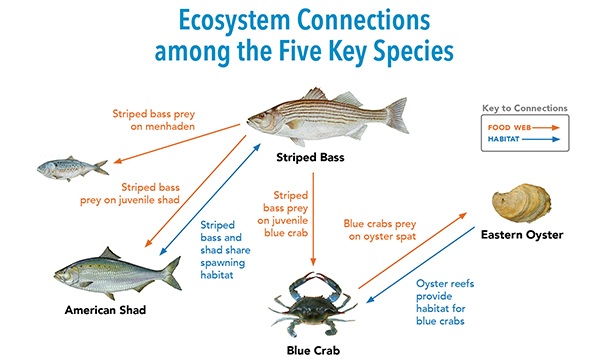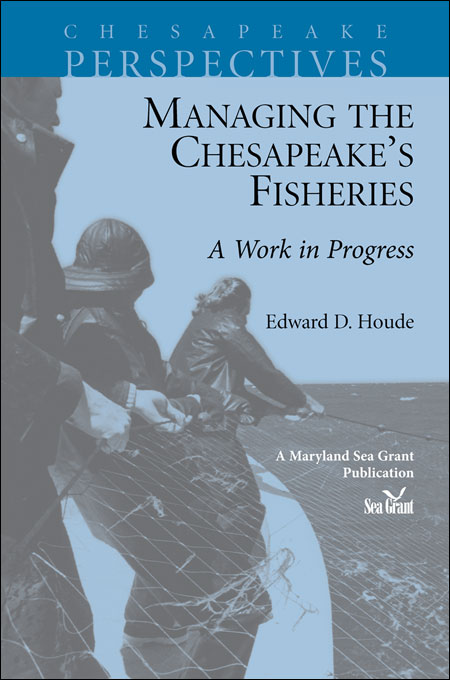Knauss legislative fellowships in Congress help build careers — and they're fun and educational. See our video and fact sheet for details.
Ecosystem-Based Fisheries Management
.jpg)
Maryland Sea Grant and its partners have developed a scientific and technical foundation for a new approach to managing the Chesapeake Bay’s fisheries. It’s called Ecosystem-Based Fisheries Management (EBFM.)
We served as facilitators for this major, ambitious effort in order to offer sound, research-based guidance to natural-resource managers responsible for key fisheries in the Chesapeake Bay. A priority goal of the EBFM approach is to foster high yields in fisheries while maintaining the structure and function of the ecosystem.

Why and How We Undertook This Project
- Stressed fisheries: Populations of these species have declined and fluctuated in recent years because of numerous environmental stressors:
- A holistic approach: The EBFM approach moves beyond traditional management that typically has focused on managing single species in isolation and controlling fishers and harvest limits. The new approach considers the interconnections among species, their physical and living environments, and human influences. This evolution in method is needed because traditional management approaches have not been effective in managing stocks. EBFM takes into account environmental stressors, like degraded water quality and fish diseases, that have damaged the Bay’s major commercial and recreational fisheries.
- A recognized model: The EBFM approach has been endorsed widely in fishery research and policy circles outside the Chesapeake Bay region for more than a decade.
- Public input: The new approach developed by Maryland Sea Grant and its partners relied heavily on a bottom-up process. We sought out and considered the views and needs of watermen and other people affected by fishery regulations.
Results to Date
- This project produced these summary and background reports:
Alosines: summary background
Blue crab: summary background
Menhaden: summary background
Striped bass: summary background
Note: Oysters may be considered for EBFM in the future.
- These reports were distributed among regulators at the Maryland Department of Natural Resources and other EBFM partners.
- Maryland Sea Grant solicited research proposals for study of socioeconomic aspects of EBFM for the Chesapeake Bay. Two proposals were selected.
- This solid foundation is poised to support a new multi-species, ecosystem-centered approach to managing fisheries in the Chesapeake Bay. Maryland Sea Grant looks forward to continuing this dialogue with its partners and those with an interest in these issues.
For additional insights about EBFM in the Chesapeake Bay, read Managing the Chesapeake's Fisheries: A Work in Progress, for sale in our Bookstore. This book, part of Maryland Sea Grant’s Chesapeake Perspectives series, summarizes current management efforts, potential implications of climate change, disease challenges, and the need for new science. It was written by Edward D. Houde of the Chesapeake Biological Laboratory at the University of Maryland Center for Environmental Science.
For more information about EBFM, contact Fredrika C. Moser, Ph.D., director, Maryland Sea Grant.
How EBFM Information Was Developed
Maryland Sea Grant is uniquely positioned to facilitate the development of an EBFM framework for Chesapeake Bay fisheries. We have a track record as an unbiased platform for discussion and building consensus on Chesapeake Bay issues involving science.
For the EBFM project, we recruited more than 85 scientists, natural-resource managers, and representatives of nongovernmental organizations (NGOs) from within and beyond the Bay region who volunteered their expertise.
Experts served on one of four panels called Species Teams. Each panel studied a different key species.
Each team worked to identify the critical ecosystem stressors for the species and to explain these in reports. This information could serve as a foundation to inform the development of fishery performance measures and reference points (to help managers determine appropriate harvest levels for each species.)
Maryland Sea Grant facilitated this work by recruiting the experts, convening workshops, and helping to synthesize the scientific consensus that emerged from the committees’ work. We also communicated the panels’ guidance to stakeholders and fishery managers, including the Chesapeake Bay Program’s Goal Implementation Team for Sustainable Fisheries.




